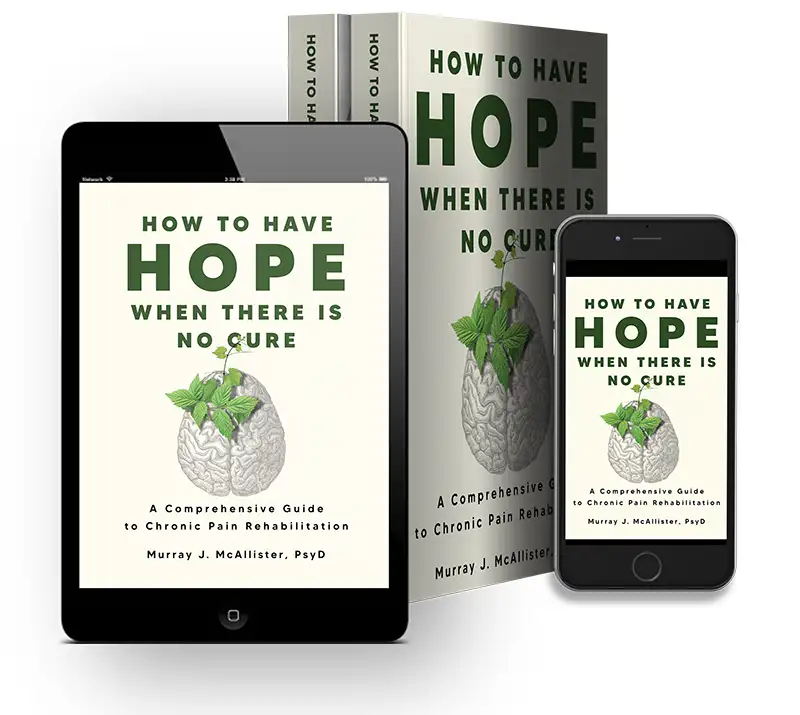
You can find the hardcover, paperback, and ebook versions here or wherever you buy your books
The Institute has provided those living with chronic pain, their family members and their providers evidence-based digestible information about chronic pain for over ten years. We are pleased to be publishing How to Have Hope When There Is No Cure: A Comprehensive Guide to Chronic Pain Rehabilitation. This groundbreaking book is the culmination of decades of work by our late founder, Dr. Murray J McAllister, PsyD, and serves as the pinnacle of our mission; to make pain management more effective by changing the culture of how chronic pain is treated. With the publication of this book, we will no longer be adding new content to our website or social channels, but current content will remain available.How Important is Pain Reduction with Opioids?
Just this morning, a primary care provider came to consult with me, looking for pain rehabilitation options for her patient with a complex set of needs. Emphasizing the legitimacy of the patient’s pain complaints, the provider detailed a long history of an active substance use disorder. The patient has had multiple urine drug screens positive for both opioids, which weren’t prescribed to the patient, and illegal substances. The provider recounts that the patient has been asked to leave multiple pain clinics for similar aberrant prescription drug use behaviors, all of which are indicative of an inability to control the use of opioids. Given the patient's history, she is at high risk of further exacerbating her addiction and/or death, if opioids continue to be prescribed. Nevertheless, the provider feels as if she has to prescribe opioids to the patient because, "she has legitimate medical conditions with real pain."
Opioid Dependency and the Intolerability of Pain
The most vexing of all questions in the debate over long-term opioid management for pain is subtle, difficult to articulate, and rarely considered. It lies at the heart of whether and how we maintain patients with severe pain on long-term opioids or whether we help them learn to self-manage it instead.
This most vexing of questions involves how we understand the nature of pain severity and its relationship to its degree of tolerability in the long-term opioid management patient. For depending on how we understand the intolerability of severe pain, it leads to contradictory treatment considerations among well-meaning, competent patients and providers, and even within the larger society.
Opioids, or narcotic pain medications, are commonly thought of as powerful pain relievers. Patients frequently request them and healthcare providers often prescribe them for back pain because they think that opioids are the most effective pain reliving treatment. Popular media and others in society also commonly think that without opioids patients will suffer intolerable or “intractable” back pain. The implication is that, again, opioids are the most powerful and effective pain reliever.
But are they the most effective pain relieving treatment for back pain?
Few topics in healthcare generate more passion than the use of opioid medications for chronic, non-cancer pain. Some, in the debate, lead the charge for greater access to opioids, arguing fervently that these medications are under-prescribed, while others call for more limited access, arguing that opioids are over-prescribed. The central focus for these strong feelings is typically the issue of addiction, but other issues commonly receive attention as well, such as the effectiveness of opioids and humanitarian calls to alleviate suffering.
Opioid Management
Opioid, or narcotic, pain medications are beneficial in many ways. Patients with pain from terminal cancer benefit from their use. Patients benefit from their short-term use when recovering from an acute injury or following a painful surgical procedure. However, the long-term use of opioid medications for chronic, noncancer pain remains quite controversial.
-
Opioid Tapering as an Exposure-based Therapy for Chronic Pain
“Thank you. I’m so grateful to all of you. You’ve given me my life back… but why did it take so long for me to be referred to this program?” This series of statements, along with the concluding question, is… -
What is Cognitive Behavioral Therapy for Pain?
Cognitive behavioral therapy is a traditional form of therapy that is used for a great many types of health conditions. Historically beginning in the 1970’s, it was first used as treatments for chronic pain and depression,1, 2 but later applied to… -
Why See a Psychologist for Pain?
People are sometimes surprised that there are psychologists who are not mental health providers. It’s also true for people with persistent pain who might wonder why their physician referred them to a psychologist for the management of pain. ‘I’m not… -
Whatever Happened to Backache?
You’d think that we’d all agree on what back pain is. Pain in the low back is almost as common as days of the week. Most everyone has had or will have back pain in the course of their lives… -
Should the Definition of Opioid Addiction Change?
Twenty some odd years ago, the American Academy of Pain Medicine and the American Pain Society, two large pain-related professional organizations, teamed up to agree upon what it means to have both chronic pain and be addicted to opioid pain…




